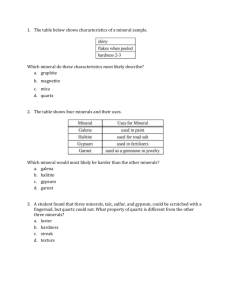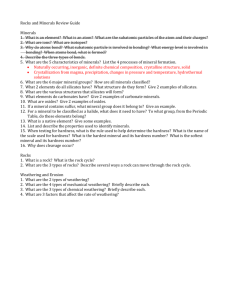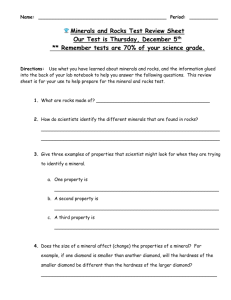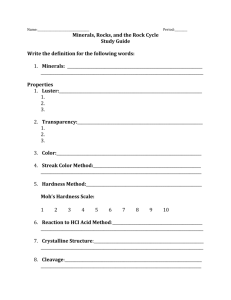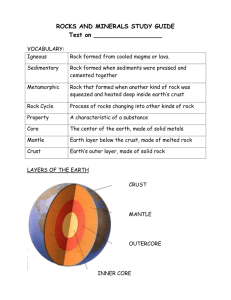GL1 Minerals and Rocks
advertisement
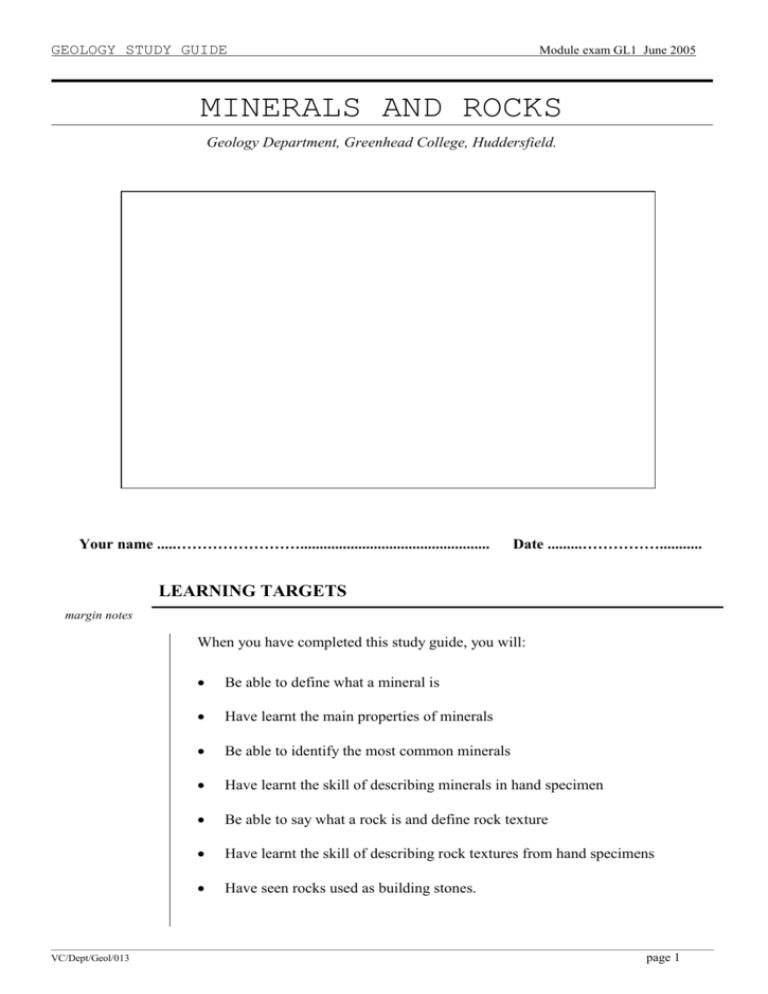
GEOLOGY STUDY GUIDE Module exam GL1 June 2005 MINERALS AND ROCKS Geology Department, Greenhead College, Huddersfield. Your name .....……………………................................................. Date .........……………........... LEARNING TARGETS margin notes When you have completed this study guide, you will: Be able to define what a mineral is Have learnt the main properties of minerals Be able to identify the most common minerals Have learnt the skill of describing minerals in hand specimen Be able to say what a rock is and define rock texture Have learnt the skill of describing rock textures from hand specimens Have seen rocks used as building stones. ______________________________________________________________________________________________________________________________ VC/Dept/Geol/013 page 1 GEOLOGY STUDY GUIDE Module exam GL1 June 2005 Resources Here is a choice of resources to use. You do not need to look at them all but clearly the more you read the better your knowledge of case studies will be. Tick the box once you have used the resource. If you read a photocopied extract then highlight it to help you reread it for revision. If you make notes from a video tape make sure that the notes are headed with the name of the tape so that you know the source of your information. MIN1 MIN2 MIN3 MIN4 MIN5 MIN6 MIN7 MIN8 MIN9 MIN10 MIN11 MIN12 MIN13 Websites www.geolsoc.org.uk/ Go to Teaching Resources www.mineral.galleries.com/Minerals/By_Name.htm geology.about.com/science/geology/cs/mineralogy/index.htm Understanding Geology David Webster p 19-25 Geoscience Edwards and King p 47-51 Geological Science by Andrew McLeish p 9-13 Video Earth Revealed- Minerals Tape 47 30 mins CD Rom Earthquest Library Eyewitness Visual Dictionary of the Earth Library NHM Gemstones Library NHM Agates Library NHM Crystals Identification key Library Skinner, B.J. and Porter, S.C., The Dynamic Earth Chap 2 Video Rocks in the Field Tape 55 23 mins Powerpoints on Mineral Properties and identification There are many other websites you could search. ______________________________________________________________________________________________________________________________ VC/Dept/Geol/013 page 2 GEOLOGY STUDY GUIDE Margin notes TASK 1 Module exam GL1 June 2005 DEFINITIONS Minerals are naturally-occurring chemical compounds or elements having distinct chemical compositions, atomic structures and physical properties which help with identification. This definition is thought to be the best to use at AS. Write it out in your own words, using diagrams and colours to help you learn it. TASK 2 TESTS AND OBSERVATIONS There are 12 main tests and observations, as follows: form, habit, twinning, cleavage, fracture, hardness, density, streak, lustre, colour, degree of transparency and reaction with dilute hydrochloric acid. What is the difference between a test and an observation? Write down your answer. Make a list to show which are tests and which are observations. You need to learn how to carry out each one so be ready to make some notes in class from the powerpoints. TASK 3 TESTS AND OBSERVATIONS Watch the first 15 minutes of MIN 4 and make notes on any features that you think might help you understand mineral identification TASK 4 HARDNESS Hardness is one of the most useful tests so copy out Moh’s hardness scale from MIN 1 p23 or MIN 2 p 48. Look at the Moh’s hardness kit we have in the classroom. It allows an accurate assessment of mineral hardness but is not usually used except by professionals. We use a simpler version, using common examples, which gives the range of hardness of any mineral. The hardness of a fingernail is about 2.5, of a penny or other copper coin 3.5 and of a good steel pin or knife blade 5.5. Learn these ranges of hardness as they will help you to identify minerals in practicals. TASK 5 SPECIFIC GRAVITY Specific gravity is a measure of how dense a mineral is. You can hold a specimen in your hand and estimate whether it is dense or less dense – this is called hefting the specimen. To measure the specific gravity accurately it is necessary to carry out an experiment. Using the diagram on the front cover of the study guide, explain in your own words how you could measure and calculate specific gravity. MIN 1 p 24 will help. Use this box for notes ______________________________________________________________________________________________________________________________ VC/Dept/Geol/013 page 3 GEOLOGY STUDY GUIDE Margin notes Module exam GL1 June 2005 TASK 6 PRACTICAL Read the two inset boxes in MIN 1 p 24 which tell you how minerals should be described. Now carry out practicals on the 17 minerals listed below using the practical sheets. You should draw each specimen and add arrows to point out the main features or observations. It is not essential to be able to draw well but you must be neat with your labels. Add a scale to show how large you have drawn the specimen. You will need to have a lens and microscope on your table to help you. Also collect a streak plate, steel pin and a bottle of acid from the drawers. Good light helps you to see cleavage, twinning and lustre of minerals. Minerals must be drawn in pencil. When you comment on tests such as streak, hardness or reaction to acid make a note in the box to say what you have found out. quartz halite olivine haematite chalcopyrite calcite gypsum pyrite galena fluorite feldspars (orthoclase and plagioclase) micas (biotite and muscovite) hornblende augite barite Feldspars are a large group of minerals but the two most important ones are orthoclase and plagioclase. Similarly the most important of the mica minerals are biotite and muscovite. TASK 7 YOUR FAVOURITE MINERAL Choose your favourite mineral. Use all the resources you can find to research the appearance, properties and formation of your mineral. Write an illustrated report which will probably be 2 pages in length, or make a powerpoint presentation. Use plain paper for drawings. Keep your work neat because it could be put on display. TASK 8 IDENTIFICATION KEYS These are often valuable as a quick means of identifying minerals. Look at MIN 10 and see if you think it would be useful to you. TASK 9 EXAM QUESTION PACK Complete the Minerals EQP Deadline: ………………………………………………. Use this box for notes ______________________________________________________________________________________________________________________________ VC/Dept/Geol/013 page 4 GEOLOGY STUDY GUIDE Margin notes Module exam GL1 June 2005 TASK 10 WHAT IS A ROCK? Rocks are composed of aggregates of minerals. The three main rock groups are igneous, sedimentary and metamorphic rocks. How is each group of rocks formed? Read MIN 1 p27 as an introduction to the topic of rocks. Make a table for each group and list as many rocks as you can in the correct group. TASK 11 ROCK TEXTURE Texture means size, shape and arrangements of the crystals or particles in a rock. We will make some notes about the likely texture of igneous, sedimentary and metamorphic rocks knowing their method of formation. TASK 12 EXERCISE ON ROCK TEXTURES Use each of the following words in a sentence to show that you know what type of rock group they refer to. Here is an example: Igneous and metamorphic rocks are crystalline. clastic grain size foliation cement alignment banding TASK 13 PRACTICAL There are 7 major rock lithologies that you need to learn to identify - sandstone, limestone, shale, granite, basalt, slate, gneiss. Draw and label fully the hand specimens you select from the red trays. Look at a number of the different types in each tray and then choose the specimen you will find easiest to remember and learn from. Use the practical sheets as you did with minerals. Comment on colour, grain or crystal size, foliation, alignment and any other features, such as fossils. Say whether you think the rock is clastic or crystalline and whether it is sedimentary, igneous or metamorphic. Remember that the terminology for rock textures is very different from that of minerals. For instance you cannot assess the hardness of a rock in the same way as you can use Moh’s scale for minerals. Because rocks are aggregates of minerals you would need to look at each mineral in turn which is difficult as the minerals are too small in most rocks. Date for test on rock textures: ………………………………… Use this box for notes ______________________________________________________________________________________________________________________________ VC/Dept/Geol/013 page 5 GEOLOGY STUDY GUIDE Margin notes Module exam GL1 June 2005 TASK 14 BUILDING STONES Polished cladding stone shows rock textures very well. It is used on the fronts of shops and banks in most town centres, including Huddersfield. Follow one of the itineraries in the Huddersfield Building Stones Guide. Using the guide book, choose five interesting rocks. Name your five rocks and record field notes in your field note book using your terminology for rock textures. You may need to take a lens and ruler with you to measure grain size. Here is a list of the features you could record although not all will apply to every rock: grain/crystal size fossils composition of minerals alignment foliation colour TASK 15 EXAM QUESTION PACK Complete the Rock Textures EQP Deadline: …………………………………… TASK 16 PERSONAL RECORD SHEET Complete a personal record sheet to check your understanding and your skills learning. Deadline: ……………………………………. TASK 17 SUMMARY NOTES Make notes to summarise this topic, using the Learning Targets as a guide Summary notes deadline ………………………………………………… Use this box for notes ______________________________________________________________________________________________________________________________ VC/Dept/Geol/013 page 6

